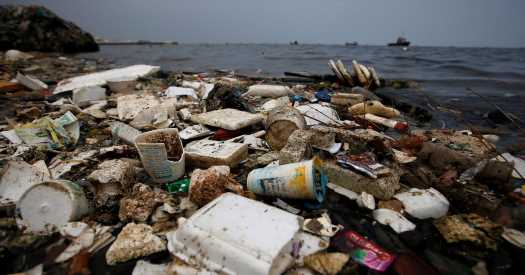A major component of ocean pollution is less devastating and more manageable than usually portrayed, according to a scientific team at the Woods Hole Oceanographic Institution on Cape Cod, Mass., and the Massachusetts Institute of Technology.
Previous studies, including one last year by the United Nations Environment Program, have estimated that polystyrene, a ubiquitous plastic found in trash, could take thousands of years to degrade, making it nearly eternal. But in a new paper, five scientists found that sunlight can degrade polystyrene in centuries or even decades.
“Policymakers generally assume that polystyrene lasts forever,” Collin P. Ward, a marine chemist at Woods Hole and the study’s lead author said in a statement on Thursday. “That’s part of the justification for writing policy that bans it.” A main rationale for his team’s study, he added, “was to understand if polystyrene actually does last forever.”
Polystyrene, one form of which often carries the brand name Styrofoam, is used to manufacture single-use cups, straws, yogurt containers, disposable razors, plastic tableware, packing materials and many other everyday items, which are discarded daily by the ton. Much of it ends up in the ocean. A swirling mass of throwaway junk known as the Great Pacific Garbage Patch, located between Hawaii and California, is estimated to occupy an area roughly twice the size of Texas.
Many nations, companies, citizen groups and ocean institutes, as well as United Nations programs, have worked hard to ban single-use items and better regulate their disposal.
“We’re not calling the concerns or the actions wrong,” Christopher M. Reddy, a marine chemist at Woods Hole and another author on the study, said in an interview. “We just have a new thread to add and we think it’s significant.”
The study was published Thursday in the journal Environmental Science and Technology Letters, a publication of the American Chemical Society, a scientific group based in Washington.
The research was funded by the Andrew W. Mellon Foundation, the Frank and Lisina Hoch Endowed Fund at Woods Hole, the Stanley Watson Chair in Oceanography at Woods Hole and a graduate research fellowship from the National Science Foundation, a federal agency.
It’s common knowledge that sunlight can cause plastics to weather. “Just look at plastic playground toys, park benches, or lawn chairs, which can rapidly become sun-bleached,” Dr. Ward noted in the Woods Hole statement.
The new study demonstrated that sunlight does even more, breaking down polystyrene into basic chemical units of organic carbon, which dissolves in seawater, and trace amounts of carbon dioxide, at levels far too low to play a role in climate change. By the end of this process the plastic has effectively disappeared from the environment.
In the paper, the researchers described the study as “the first direct evidence” of how of sunlight can break down polystyrene in the environment into its basic chemical building blocks.
Previous studies focused largely on the degrading effect of microbes. That made sense, Dr. Reddy, said, because microbes can eat many forms of organic carbon. But, he added, the chemical structure of polystyrene — particularly its backbone of large, ringed molecules — made the plastic unappetizing to decomposing bacteria.
However, that same molecular backbone turned out to be “the perfect shape and size to catch certain frequencies of sunlight,” Dr. Reddy said. And the energy that is absorbed breaks the chemical bonds.
In the lab, the researchers tested five different samples of polystyrene to see if sunlight could tear them apart. The team submerged each sample in a sealed glass container of water and exposed it to light from a solar simulator, a special lamp that mimics the frequencies of sunlight. The scientists then studied the water for evidence of breakdown products.
With sophisticated tools of detection and analysis, Dr. Ward and his colleagues then traced the origin of the loose materials back to the polystyrene. “We used multiple methods, and they all pointed to the same outcome,” he said in the statement: sunlight can turn polystyrene from a solid material back into basic chemical units.
The study also found that additives to polystyrene, which can determine its color, flexibility and other physical features, can slow or speed decomposition.
In a joint interview, Dr. Ward and Dr. Reddy said that one remaining puzzle concerns the exact nature of the dissolved organic carbon, which is too small in size to form visible particles. “We feel confident we can figure it out,” Dr. Reddy said.
The research team included Cassia J. Armstrong and Julia H. Jackson of Woods Hole, and Anna N. Walsh of Woods Hole and the Massachusetts Institute of Technology.
In the paper, the authors noted that the newly identified means of polystyrene breakdown “should be incorporated into global fate models” for plastics and help frame policy. None of the current inventories “account for degradation,” Dr. Ward noted.
In the interview, he and Dr. Reddy suggested that the new finding might eventually shed light on one of the outstanding mysteries of ocean pollution: that more than 99 percent of the plastic that should be identifiable is missing. Expeditions that have specifically looked for evidence of the calculated mass of plastic have repeatedly come up with surprisingly low returns.
In time, Dr. Ward said, the accelerating search for the breakdown products of polystyrene and other kinds of oceanic pollution may let scientists “balance the books.”
William J. Broad is a science journalist and senior writer. He joined The Times in 1983, and has shared two Pulitzer Prizes with his colleagues, as well as an Emmy Award and a DuPont Award. @WilliamJBroad
Source: Read Full Article
